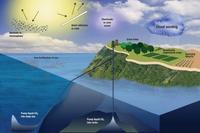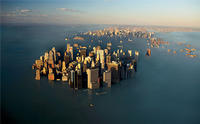-
Birds in and around Chernobyl's exclusion zone adapting to ionizing radiation

Birds in the exclusion zone around Chernobyl are adapting to — and may even be benefiting from — long-term exposure to radiation, ecologists have found. The study is first evidence that wild animals adapt to ionizing radiation, and the first to show that birds which produce most pheomelanin, a pigment in feathers, have greatest problems coping with radiation exposure.
-
-
Businesses take more responsibility for sustainable freshwater use
Growing freshwater scarcity owing to rising water demands and a changing climate is increasingly perceived as a major risk for the global economy. In a special issue of Nature Climate Change, devoted to this emerging global concern, researchers argue that consumer awareness, private sector initiatives, governmental regulation, and targeted investments are urgently necessary to move toward sustainable water use across value chains.
-
-
Threats from insiders are the most serious security challenges nuclear facilities face

Insider threats are the most serious challenge confronting nuclear facilities in today’s world, a new study says. In every case of theft of nuclear materials where the circumstances of the theft are known, the perpetrators were either insiders or had help from insiders, the study found. Theft is not the only danger facing facility operators; sabotage is a risk as well, the study authors say.
-
-
New York public transit systems preparing for sea-level rise
The Metropolitan Transportation Authority (MTA), which operates many New York state public transit lines, is beginning measures to factor for future sea-level rises within its projected five-year capital plans.Tobey Ritz, chief engineer of capital engineering at Metro-North, said: “It’s not so much for us to pick which study [of sea-level rise] is right, but to look at the entire range [of sea-level rise predictions], look at the time frames that are predicted and then consider when is the right time to act.”
-
-
Intelligent urban planning to drive climate change solutions
A leaked report from the Intergovernmental Panel on Climate Change (IPCC) suggests that intelligent urban planning and investment in public transportation, especially in developing countries, could be the key factors in lower greenhouse gas emissions and reversing the effects of climate change.
-
-
Promoting nuclear power to avoid geoengineering

There are two basic geoengineering strategies to reduce climate change: injecting aerosols such as sulfates into the stratosphere to block a portion of the sun’s radiation and thereby cool the Earth, much as volcanic emissions do; and the large-scale removal of carbon dioxide from the atmosphere. The aerosol-injection approach is much more likely to be pursued at current stages of technological development. Scientists say that in order to avoid the need for geoengineering, which could have enormous unforeseen consequences, the international community should pursue increased deployment of nuclear power plants, which do not emit carbon dioxide, to address the climate crisis. Many climate scientists are generally supportive of nuclear engineering and less fearful of it than they are of geoengineering.
-
-
Major step toward stronger encryption technology announced
Researchers the other day announced the first successful trial of Quantum Key Distribution (QKD) technology over a live “lit” fiber network. The trial paves the way for more advanced research into QKD, the next frontier of data encryption technology, which will deliver even greater levels of network security.
-
-
Odds of storm waters overflowing Manhattan seawall up 20-fold, new study says

Maximum water levels in New York harbor during major storms have risen by nearly two and a half feet since the mid-1800s, making the chances of water overtopping the Manhattan seawall now at least twenty times greater than they were 170 years ago, according to a new study. Whereas sea-level rise, which is occurring globally, has raised water levels along New York harbor by nearly a foot and a half since the mid-nineteenth century, the research shows that the maximum height of the city’s “once-in-10-years” storm tide has grown additionally by almost a foot in that same period.
-
-
Emergency water treatment guidelines questioned
During floods and other emergencies, treating water for drinking is a must, but how to do it is up for debate. The Environmental Protection Agency’s (EPA’s) recommendations for treating water after a natural disaster or other emergencies call for more chlorine bleach than is necessary to kill disease-causing pathogens and are often impractical to carry out, a new study has found.
-
-
Avoiding water wars between fracking industry and residents
The shale gas boom has transformed the energy landscape in the United States, but in some drier locations, it could cause conflict among the energy industry, residents, and agricultural interests over already-scarce water resources, say researchers. They add that degraded water quality is a potential risk unless there are adequate safeguards.
-
-
One in ten American schoolchildren in school near risky chemical facility
One year after the fertilizer facility explosion in West, Texas, which destroyed and severely damaged nearby schools, nearly one in ten American schoolchildren live and study within one mile of a potentially dangerous chemical facility. A new study shows that 4.6 million children at nearly 10,000 schools across the country are within a mile of a facility which produces, uses, or stores significant quantities of hazardous chemicals identified by EPA as particularly risky to human health or the environment if they are spilled, released into the air, or are involved in an explosion or fire.
-
-
Dams will not reduce flow of sand to Mississippi River Delta

The wetlands of the Mississippi River Delta are slowly sinking and rapidly eroding, but new research has found the river’s supply of sand — the material engineers most need to rebuild the delta — will stay constant for centuries. The new study is encouraging news for scientists and government officials who are working to shore up southeastern Louisiana’s rapidly disappearing wetlands.
-
-
S.C. fights to keep costly plutonium processing project alive
The United States and Russia have agreed to dispose of thirty-four tons of weapon-grade plutonium each, an amount equal to 17,000 nuclear warheads. The United States budgeted $4 billion for a mixed-oxide fuel project, known as MOX, at the Savannah River Site, S.C., to process the plutonium, but construction costs have now reached $8 billion, and officials estimate the facility will cost about $30 billion over its operating years. DOE has suspended the MOX project and is looking for alternative plutonium processing methods. South Carolina has sued the federal government, arguing that since Congress has authorized the funds for MOX, the administration must spend the money.
-
-
Some see small modular reactors as offering a better future for the nuclear industry
A full-size reactor costs up to $8 billion, takes years to build, and decades to achieve a return on investment. Some experts say the future of the nuclear industry should be based on small underground reactors, which are cheaper and quicker to build. Other experts say that smaller reactors mean needing many more of them to produce the same amount of power as traditional reactors, and having more reactors means increasing security concerns.
-
-
Helping Kansas counties deal with deficient bridges
Seventy-eight of the 105 counties in the state of Kansas have bridges on low-volume rural roads in dire need of repair, replacement, or removal. With an estimated cost of $150,000 per bridge — and nearly 1,000 bridges across the state in the structurally deficient or functionally obsolete categories — replacement bridges are an expensive proposition. A new study offers a way to determine which bridges should be repaired, and which should be closed.
-
More headlines
The long view
Helping Strengthen America’s Critical Infrastructure
Everyday life depends on a robust infrastructure network that provides access to running water, communications technology and electricity, among other basic necessities. The experts who keep our national infrastructure secure and resilient also need a strong network to share their knowledge and train the next generation of professionals capable of solving complex infrastructure challenges.
AI and the Future of the U.S. Electric Grid
Despite its age, the U.S. electric grid remains one of the great workhorses of modern life. Whether it can maintain that performance over the next few years may determine how well the U.S. competes in an AI-driven world.
Using Liquid Air for Grid-Scale Energy Storage
New research finds liquid air energy storage could be the lowest-cost option for ensuring a continuous power supply on a future grid dominated by carbon-free but intermittent sources of electricity.
Enhanced Geothermal Systems: A Promising Source of Round-the-Clock Energy
With its capacity to provide 24/7 power, many are warming up to the prospect of geothermal energy. Scientists are currently working to advance human-made reservoirs in Earth’s deep subsurface to stimulate the activity that exists within natural geothermal systems.
Experts Discuss Geothermal Potential
Geothermal energy harnesses the heat from within Earth—the term comes from the Greek words geo (earth) and therme (heat). It is an energy source that has the potential to power all our energy needs for billions of years.
